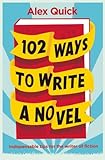102 ways to write a novel : indispensable tips for the writer of fiction / Alex Quick
Material type: TextLanguage: English Publication details: New York : Old Street Publishing, 2012Description: 233 p. ; 21 cmISBN:
TextLanguage: English Publication details: New York : Old Street Publishing, 2012Description: 233 p. ; 21 cmISBN: - 9781906964924
- One hundred and two ways to write a novel
- 808.3
- PN 3365 Q6o 2012
| Item type | Current library | Home library | Collection | Shelving location | Call number | Vol info | Copy number | Status | Date due | Barcode |
|---|---|---|---|---|---|---|---|---|---|---|
 Libro
Libro
|
Biblioteca Juan Bosch | Biblioteca Juan Bosch | Humanidades | Humanidades (4to. Piso) | PN 3365 Q6o 2012 (Browse shelf(Opens below)) | 1 | 1 | Available | 00000119085 |
Browsing Biblioteca Juan Bosch shelves, Shelving location: Humanidades (4to. Piso), Collection: Humanidades Close shelf browser (Hides shelf browser)

|

|

|

|

|

|

|
||
| PN3365 .M776 2010 | PN 3365 M776c 2010 The complete idiot's guide to writing a novel / | PN 3365 M966w 2016 The writer's guide to beginnings : how to craft story openings that sell / | PN 3365 P337l 2013 The lives of the novel : a history / | PN 3365 Q6o 2012 102 ways to write a novel : indispensable tips for the writer of fiction / | PN 3365 R264w 1994 The weekend novelist / | PN 3365 R613y 2006 Your first novel : a published author and a top agent share the keys to achieving your dream / | PN 3365 S354b 2015 Book in a month : the fool-proof system for writing a novel in 30 days / |
Cover; Title Page; Dedication; CONTENTS; INTRODUCTION; BEFORE YOU START; 1.: CONSIDER YOUR MOTIVES; 2.: THINK ABOUT WHAT SORT OF NOVEL YOU WANT TO WRITE; 3.: HOW FAR SHOULD YOU WRITE FOR A MARKET?; 4.: THINK ABOUT THE ROLE OF THE STORYTELLER; 5.: CAN WRITING BE TAUGHT?; PRACTICAL CONSIDERATIONS; 6.: MAKE TIME AND SPACE FOR WRITING; 7.: WRITE IN THE MORNINGS?; 8.: DECIDE ON A WORD-COUNT; 9.: KEEP A COMMONPLACE BOOK; 10.: COMPUTERS OR PAPER?; 11.: JOIN A WRITERS' GROUP; 12.: CONSIDER COLLABORATIVE WRITING; THE RESEARCH PHASE; 13.: ANSWER THE QUESTION: 'WHAT'S YOUR NOVEL ABOUT?' 14.: discover your subject15.: find a theme; 16.: visit the library; 17.: accumulate specific detail; 18.: defeat writer's block; 19.: map your mind; 20.: go!; building character; 21.: start with characters or start with plot?; 22.: draft a 'character cv'; 23.: reduce your characters to tiers; 24.: understand the job of the main character; 25.: deploy minor characters; 26.: observe yourself; 27.: observe other people; 28.: use the norman mailer method; 29.: adapt real life; 30.: use photos; 31.: introduce your characters; 32.: give your characters hidden depths. 33.: MAKE YOUR CHARACTERS WANT SOMETHING34.: SHOW CHANGE IN YOUR CHARACTERS; 35.: NAME YOUR CHARACTERS; 36.: NAME EVERYTHING ELSE; BUILDING PLOT; 37.: HOW DO YOU INVENT A PLOT?; 38.: UNDERSTAND SUSPENSE AND MYSTERY; 39.: USE CHARACTER TO GENERATE PLOT; 40.: CREATE CONFLICT; 41.: ANTICIPATE THE CLIMAX; 42.: Resolve conflict; 43.: TWIST THE PLOT; 44.: TRY A MACGUFFIN; 45.: DON'T REVERSE THE POLARITY OF THE NEUTRON FLOW; 46.: WHAT IF YOU ONLY HAVE SCENES AND NO PLOT?; 47.: WRITE A DETAILED PLOT SUMMARY; 48.: USE A THREE-ACT STRUCTURE; 49.: USE CINEMATIC TECHNIQUES; 50.: ADD A SUBPLOT. The matter of structure51.: craft a good beginning; 52.: craft a beginning that isn't really a beginning; 53.: write the first sentence; 54.: struggle through the middle; 55.: climax or denouement?; 56.: write the last sentence; 57.: split your novel into chapters; types of prose writing; 58.: give exposition -- sparingly; 59.: describe things; 60.: let your characters act; 61.: make your dialogue work; 62.: attribute your dialogue -- or don't; 63.: use dialect?; 64.: show minds at work; 65.: use letters; 66.: try a diary-novel; 67.: steal from the theatre; 68.: write with pictures. Point of view69.: get to grips with point of view; 70.: write in the first person; 71.: decide whether your narrator is reliable or unreliable; 72.: write in the third person limited; 73.: write in the third person unlimited; 74.: write using 'god's eye view'; language; 75.: acquire a style; 76.: what are the rules of style?; 77.: understand the basics of grammar and punctuation; 78.: avoid the dreaded comma splice; 79.: avoid the equally dreaded split infinitive; 80.: treat adjectives and adverbs with caution; other things to consider; 81.: manage the flow of time.
For God's sake, keep your eyes open. Notice what's going on around you.' William S. Burroughs This step-by-step guide to the art and the craft of writing fiction is a refreshing blend of the practical (how to find an agent), with the more cerebral (how to handle point of view; the importance of rhythm). Throughout, Quick uses the hard-won experiences of his fellow novelists to give colour and depth to his own advice. Did you know, for instance, that Road Dahl wrote in a shed? That Nabokov composed his masterpieces on index cards? Or that most writers get their best work done in the morn.


There are no comments on this title.